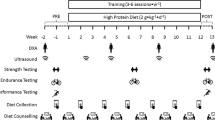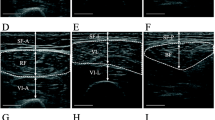Abstract
Purpose
It has been proposed that skeletal muscle shows signs of resistance training (RT)-induced muscle hypertrophy much earlier (i.e., ~3–4 weeks of RT) than previously thought. We determined if early increases in whole muscle cross-sectional area (CSA) during a period of RT were concomitant with edematous muscle swelling and thus not completely attributable to hypertrophy.
Methods
We analyzed vastus lateralis muscle ultrasound CSA images and their respective echo intensities (CSA-USecho) at the beginning (T1), in the 3rd week of RT (T2) and at the end (T3) of a 10-week RT period in ten untrained young men. Functional parameters [training volume (TV = load × reps × sets) and maximal voluntary contraction (MVC)] and muscle damage markers (myoglobin and interleukin-6) were also assessed.
Result
Muscle CSA increased significantly at T2 (~2.7 %) and T3 (~10.4 %) versus T1. Similarly, CSA-USecho increased at T2 (~17.2 %) and T3 (~13.7 %). However, when CSA-USecho was normalized to the increase in muscle CSA, only T2 showed a significantly higher USecho versus T1. Additionally, TV increased at T2 and T3 versus T1, but MVC increased only at T3. Myoglobin and Interleukin-6 were elevated at T2 versus T1, and myoglobin was also higher at T2 versus T3.
Conclusion
We propose that early RT-induced increases in muscle CSA in untrained young individuals are not purely hypertrophy, since there is concomitant edema-induced muscle swelling, probably due to muscle damage, which may account for a large proportion of the increase. Therefore, muscle CSA increases (particularly early in an RT program) should not be labeled as hypertrophy without some concomitant measure of muscle edema/damage.


Similar content being viewed by others
Abbreviations
- ANOVA:
-
Analysis of variance
- AU:
-
Arbitrary units
- CSA:
-
Cross-sectional area
- CSA-USecho :
-
Cross-sectional area echo-intensity
- ES:
-
Effect size
- IL-6:
-
Interleukin-6
- Mb:
-
Myoglobin
- MVC:
-
Maximum voluntary isometric contraction torque
- MPS:
-
Muscle protein synthesis
- MRI:
-
Magnetic resonance imaging
- RT:
-
Resistance training
- SD:
-
Standard deviations
- TV:
-
Total training volume
- USecho :
-
Ultrasound echo-intensity
- VL:
-
Vastus lateralis
References
Berg HE, Tedner B, Tesch PA (1993) Changes in lower limb muscle cross-sectional area and tissue fluid volume after transition from standing to supine. Acta Physiol Scand 148(4):379–385. doi:10.1111/j.1748-1716.1993.tb09573.x
Burd NA, West DW, Staples AW, Atherton PJ, Baker JM, Moore DR, Holwerda AM, Parise G, Rennie MJ, Baker SK, Phillips SM (2010) Low-load high volume resistance exercise stimulates muscle protein synthesis more than high-load low volume resistance exercise in young men. PLoS One 5(8):e12033. doi:10.1371/journal.pone.0012033
Cermak NM, Res PT, de Groot LC, Saris WH, van Loon LJ (2012) Protein supplementation augments the adaptive response of skeletal muscle to resistance-type exercise training: a meta-analysis. Am J Clin Nutr 96(6):1454–1464. doi:10.3945/ajcn.112.037556
Chen TC, Nosaka K (2006) Responses of elbow flexors to two strenuous eccentric exercise bouts separated by three days. J Strength Cond Res 20(1):108–116
Chen TC, Chen HL, Lin MJ, Wu CJ, Nosaka K (2009) Muscle damage responses of the elbow flexors to four maximal eccentric exercise bouts performed every 4 weeks. Eur J Appl Physiol 106(2):267–275
Chen HL, Nosaka K, Pearce AJ, Chen TC (2012) Two maximal isometric contractions attenuate the magnitude of eccentric exercise-induced muscle damage. Appl Physiol Nutr Metab 37(4):680–689. doi:10.1139/h2012-035
Chen TC, Chen HL, Lin MJ, Chen CH, Pearce AJ, Nosaka K (2013) Effect of two maximal isometric contractions on eccentric exercise-induced muscle damage of the elbow flexors. Eur J Appl Physiol 113(6):1545–1554. doi:10.1007/s00421-012-2581-8
Conceição MS, Libardi CA, Nogueira FR, Bonganha V, Gaspari AF, Chacon-Mikahil MP, Cavaglieri CR, Madruga VA (2012) Effects of eccentric exercise on systemic concentrations of pro- and anti-inflammatory cytokines and prostaglandin (E2): comparison between young and postmenopausal women. Eur J Appl Physiol 112(9):3205–3213. doi:10.1007/s00421-011-2292-6
Damas F, Phillips S, Vechin FC, Ugrinowitsch C (2015) A review of resistance training-induced changes in skeletal muscle protein synthesis and their contribution to hypertrophy. Sports Med 45(6):801–807. doi:10.1007/s40279-015-0320-0
DeFreitas JM, Beck TW, Stock MS, Dillon MA, Kasishke PR 2nd (2011) An examination of the time course of training-induced skeletal muscle hypertrophy. Eur J Appl Physiol 111(11):2785–2790. doi:10.1007/s00421-011-1905-4
Fleckenstein JL, Canby RC, Parkey RW, Peshock RM (1988) Acute effects of exercise on MR imaging of skeletal muscle in normal volunteers. AJR Am J Roentgenol 151(2):231–237. doi:10.2214/ajr.151.2.231
Fujikake T, Hart R, Nosaka K (2009) Changes in B-mode ultrasound echo intensity following injection of bupivacaine hydrochloride to rat hind limb muscles in relation to histologic changes. Ultrasound Med Biol 35(4):687–696. doi:10.1016/j.ultrasmedbio.2008.10.008
Gonzalez-Izal M, Lusa Cadore E, Izquierdo M (2014) Muscle conduction velocity, surface electromyography variables, and echo intensity during concentric and eccentric fatigue. Muscle Nerve 49(3):389–397
Hartman JW, Tang JE, Wilkinson SB, Tarnopolsky MA, Lawrence RL, Fullerton AV, Phillips SM (2007) Consumption of fat-free fluid milk after resistance exercise promotes greater lean mass accretion than does consumption of soy or carbohydrate in young, novice, male weightlifters. Am J Clin Nutr 86(2):373–381
Kamen G, Knight CA (2004) Training-related adaptations in motor unit discharge rate in young and older adults. J Gerontol A Biol Sci Med Sci 59(12):1334–1338
Krentz JR, Farthing JP (2010) Neural and morphological changes in response to a 20-day intense eccentric training protocol. Eur J Appl Physiol 110(2):333–340. doi:10.1007/s00421-010-1513-8
Lixandrao ME, Ugrinowitsch C, Bottaro M, Chacon-Mikahil MP, Cavaglieri CR, Min LL, de Souza EO, Laurentino GC, Libardi CA (2014) Vastus Lateralis muscle cross-sectional area ultrasonography validity for image fitting in humans. J Strength Cond Res 28(11):3293–3297. doi:10.1519/JSC.0000000000000532
May DA, Disler DG, Jones EA, Balkissoon AA, Manaster BJ (2000) Abnormal signal intensity in skeletal muscle at MR imaging: patterns, pearls, and pitfalls. Radiographics 20 Spec No:S295-315. doi:10.1148/radiographics.20.suppl_1.g00oc18s295
Mitchell CJ, Churchward-Venne TA, West DW, Burd NA, Breen L, Baker SK, Phillips SM (2012) Resistance exercise load does not determine training-mediated hypertrophic gains in young men. J Appl Physiol 113(1):71–77. doi:10.1152/japplphysiol.00307.2012
Moritani T, deVries HA (1979) Neural factors versus hypertrophy in the time course of muscle strength gain. Am J Phys Med 58(3):115–130
Nakagawa S, Cuthill IC (2007) Effect size, confidence interval and statistical significance: a practical guide for biologists. Biol Rev Camb Philos Soc 82(4):591–605. doi:10.1111/j.1469-185X.2007.00027.x
Newham DJ, Jones DA, Clarkson PM (1987) Repeated high-force eccentric exercise: effects on muscle pain and damage. J Appl Physiol 63(4):1381–1386
Nosaka K, Clarkson PM (1996) Changes in indicators of inflammation after eccentric exercise of the elbow flexors. Med Sci Sports Exerc 28(8):953–961
Nosaka K, Sakamoto K (2001) Effect of elbow joint angle on the magnitude of muscle damage to the elbow flexors. Med Sci Sports Exerc 33(1):22–29
Nosaka K, Newton MJ, Sacco P (2005) Attenuation of protective effect against eccentric exercise-induced muscle damage. Can J Appl Physiol 30(5):529–542
Phillips SM (2000) Short-term training: when do repeated bouts of resistance exercise become training? Can J Appl Physiol 25(3):185–193
Phillips SM, Tipton KD, Aarsland A, Wolf SE, Wolfe RR (1997) Mixed muscle protein synthesis and breakdown after resistance exercise in humans. Am J Physiol 273(1 Pt 1):E99–107
Pillen S, van Alfen N (2011) Skeletal muscle ultrasound. Neurol Res 33(10):1016–1024. doi:10.1179/1743132811Y.0000000010
Rosenberg JG, Ryan ED, Sobolewski EJ, Scharville MJ, Thompson BJ, King GE (2014) Reliability of panoramic ultrasound imaging to simultaneously examine muscle size and quality of the medial gastrocnemius. Muscle Nerve 49(5):736–740. doi:10.1002/mus.24061
Sale DG, Martin JE, Moroz DE (1992) Hypertrophy without increased isometric strength after weight training. Eur J Appl Physiol Occup Physiol 64(1):51–55
Seynnes OR, de Boer M, Narici MV (2007) Early skeletal muscle hypertrophy and architectural changes in response to high-intensity resistance training. J Appl Physiol 102(1):368–373. doi:10.1152/japplphysiol.00789.2006
Smith LL, Anwar A, Fragen M, Rananto C, Johnson R, Holbert D (2000) Cytokines and cell adhesion molecules associated with high-intensity eccentric exercise. Eur J Appl Physiol 82(1–2):61–67. doi:10.1007/s004210050652
Sorichter S, Puschendorf B, Mair J (1999) Skeletal muscle injury induced by eccentric muscle action: muscle proteins as markers of muscle fiber injury. Exerc Immunol Rev 5:5–21
Tang JE, Perco JG, Moore DR, Wilkinson SB, Phillips SM (2008) Resistance training alters the response of fed state mixed muscle protein synthesis in young men. Am J Physiol Regul Integr Comp Physiol 294(1):R172–R178. doi:10.1152/ajpregu.00636.2007
Vechin FC, Libardi CA, Conceicao MS, Damas FR, Lixandrao ME, Berton RP, Tricoli VA, Roschel HA, Cavaglieri CR, Chacon-Mikahil MP, Ugrinowitsch C (2015) Comparisons between low-intensity resistance training with blood flow restriction and high-intensity resistance training on quadriceps muscle mass and strength in elderly. J Strength Cond Res 29(4):1071–1076. doi:10.1519/JSC.0000000000000703
Wakahara T, Ema R, Miyamoto N, Kawakami Y (2015) Increase in vastus lateralis aponeurosis width induced by resistance training: implications for a hypertrophic model of pennate muscle. Eur J Appl Physiol 115(2):309–316. doi:10.1007/s00421-014-3012-9
Wilkinson SB, Tarnopolsky MA, Macdonald MJ, Macdonald JR, Armstrong D, Phillips SM (2007) Consumption of fluid skim milk promotes greater muscle protein accretion after resistance exercise than does consumption of an isonitrogenous and isoenergetic soy-protein beverage. Am J Clin Nutr 85(4):1031–1040
Wilson GJ, Murphy AJ (1996) The use of isometric tests of muscular function in athletic assessment. Sports Med 22(1):19–37
Witard OC, Jackman SR, Breen L, Smith K, Selby A, Tipton KD (2014) Myofibrillar muscle protein synthesis rates subsequent to a meal in response to increasing doses of whey protein at rest and after resistance exercise. Am J Clin Nutr 99(1):86–95. doi:10.3945/ajcn.112.055517
Young HJ, Jenkins NT, Zhao Q, McCully KK (2015) Measurement of Intramuscular Fat by Muscle Echo Intensity. Muscle Nerve. doi:10.1002/mus.24656
Acknowledgments
We would like to acknowledge all the participants of this study. This work was supported by São Paulo Research Foundation (FAPESP) Grants #2012/24499-1, #2014/19594-0 and #2013/21218-4. CU and HR are supported by the National Council for Scientific and Technological Development (CNPq) Grant (#304205/2011-7 and #307023/2014-1, respectively). Portions of this work were also supported by a Grant from the Natural Science and Engineering Research Council (NSERC) of Canada to SMP.
Author information
Authors and Affiliations
Corresponding author
Ethics declarations
Conflict of interest
The authors do not have any conflicts of interest, financial or otherwise, to declare.
Ethical standard
All procedures performed herein were in accordance with the ethical standards of the institutional and national research committee and with the 1964 Helsinki Declaration and its later amendments or comparable ethical standards.
Additional information
Communicated by Anni Vanhatalo.
Rights and permissions
About this article
Cite this article
Damas, F., Phillips, S.M., Lixandrão, M.E. et al. Early resistance training-induced increases in muscle cross-sectional area are concomitant with edema-induced muscle swelling. Eur J Appl Physiol 116, 49–56 (2016). https://doi.org/10.1007/s00421-015-3243-4
Received:
Accepted:
Published:
Issue Date:
DOI: https://doi.org/10.1007/s00421-015-3243-4




